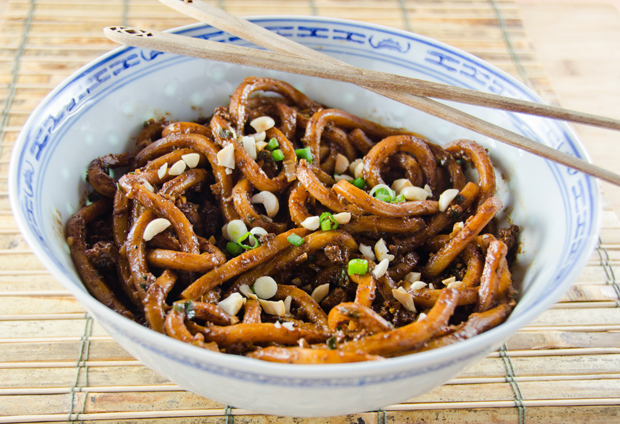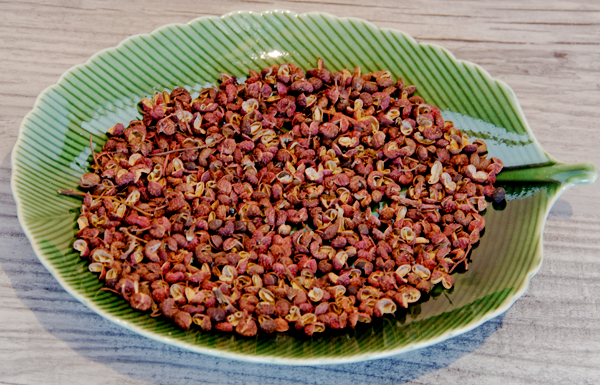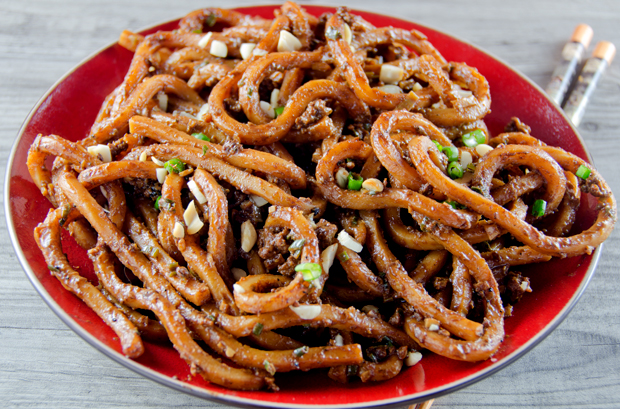Searching out new and unusual ingredients has always played an important part in my “joy of cooking”. In the olden days (the eighties) and b.i. (before Internet), the hunt would involve trips to ethnic markets, phone calls to vendors and an ever-growing stack of mail order catalogs to aid in my search. Gardening has always given us the ability to grow fresh herbs and vegetables that were not readily available in our markets. There was one elusive spice that I encountered in Chinese cookbooks that wasn’t just hard to find, but unavailable for many years in the United States, Sichuan peppercorns.
Banned in 1968, Sichuan peppercorns were safe for human consumption. The real concern here was citrus canker, a disease the imported spice could carry and infect the foliage of citrus plants in the United States. The ban was lifted in 2005 when it was discovered that heating the peppercorns to 170 degrees, killed the bacteria that harmed plants.
Sichuan peppercorns are not true peppercorns or chilies but tiny crimson berries that come from the prickly ash trees that grow in the mountainous regions of Sichuan province. The first taste of a Sichuan peppercorn on the tongue starts with the impression of a mentholy flavor with some lemony overtones followed by a numbing tingle in the mouth. According to Harold McGee, author of “On Food and Cooking”, Sichuan peppercorns can produce the same effect as carbonated drinks on the lips and tongue. Combined with chili peppers or ginger, they create a taste combination unique to Sichuan cooking, ” ma la ” or the spicy and tingly sensation left in the mouth after eating a dish with this combination. Ma means both anesthetic and “pins and needles” in Chinese. La, of course, is the spicy part of the equation, provided by chills and ginger.
Spicy Sichuan Noodles showcases the ma la combination very nicely. Using the original recipe as a starting point, we recreated a dish as best memory would allow. It was one of many dishes that we shared with friends in an excellent Sichuan restaurant hidden away in a New Jersey strip mall. Dry roasting the Sichuan peppercorns releases their aromatic oils and brings out their flavor. Only roast the amount you will be using in a recipe since the oils dissipate quickly. In our version, we chose to stir fry, not deep fry the pork. We also chose thicker udon noodles instead of Chinese egg noodles and added some roasted peanuts on top for extra crunch. Noodles are always a part of the Chinese new year celebration, as they symbolize longevity. Noodles should never be cut, even when eating. Twist those noodles around your chopsticks for a long life.
Spicy Sichuan Noodles
Adapted from “The Taste of China” by Ken Hom
Serves 4-6 as part of a Chinese meal, 2-4 as a single dish
Ingredients
- 1 tablespoon Sichuan peppercorns
- 1/2 pound ground pork
- 3 tablespoons dark soy sauce
- 3 teaspoons salt
- 3T peanut oil
- 3 tablespoons chopped garlic
- 2 tablespoons finely chopped peeled fresh ginger
- 5 tablespoons finely chopped scallions
- 2 tablespoons sesame paste or smooth peanut butter
- 2 tablespoons chili oil
- 1 cup chicken stock
- 12 ounces fresh or dry Chinese egg noodles
- 1 T toasted, chopped peanuts
Directions
- Heat a wok or heavy skillet over medium heat. Add the peppercorns and stir-fry for about 5 minutes until they brown slightly and start to smoke. Remove them from the heat and allow them to cool, then grind them. Set aside.
- Heat the same wok over medium high heat and add 1T oil. When the oil is hot add the ground pork, stirring with a spatula to break up the pieces. Add the dark soy sauce and continue to cook pork until browned, about four minutes. Remove pork with a slotted spoon and drain on paper towels.
- Bring a 3-4 quart pot of water on the stove to a boil.
- Reheat the wok with the 2 tablespoons oil and stir-fry the garlic, ginger and 4 tablespoons of the scallions for 30 seconds, then add the peanut butter or sesame paste, the remaining soy sauce and salt, the chili oil and chicken stock. Simmer for four minutes. Return the pork to the pan and stir.
- Cook the noodles in the boiling water two minutes if they are fresh, five minutes if they are dried. Drain in a colander. Transfer them to a serving bowl or individual bowls. Ladle on the sauce and top with the pork mixture. Sprinkle with the ground Sichuan peppercorns, toasted peanuts, scallions and serve.


